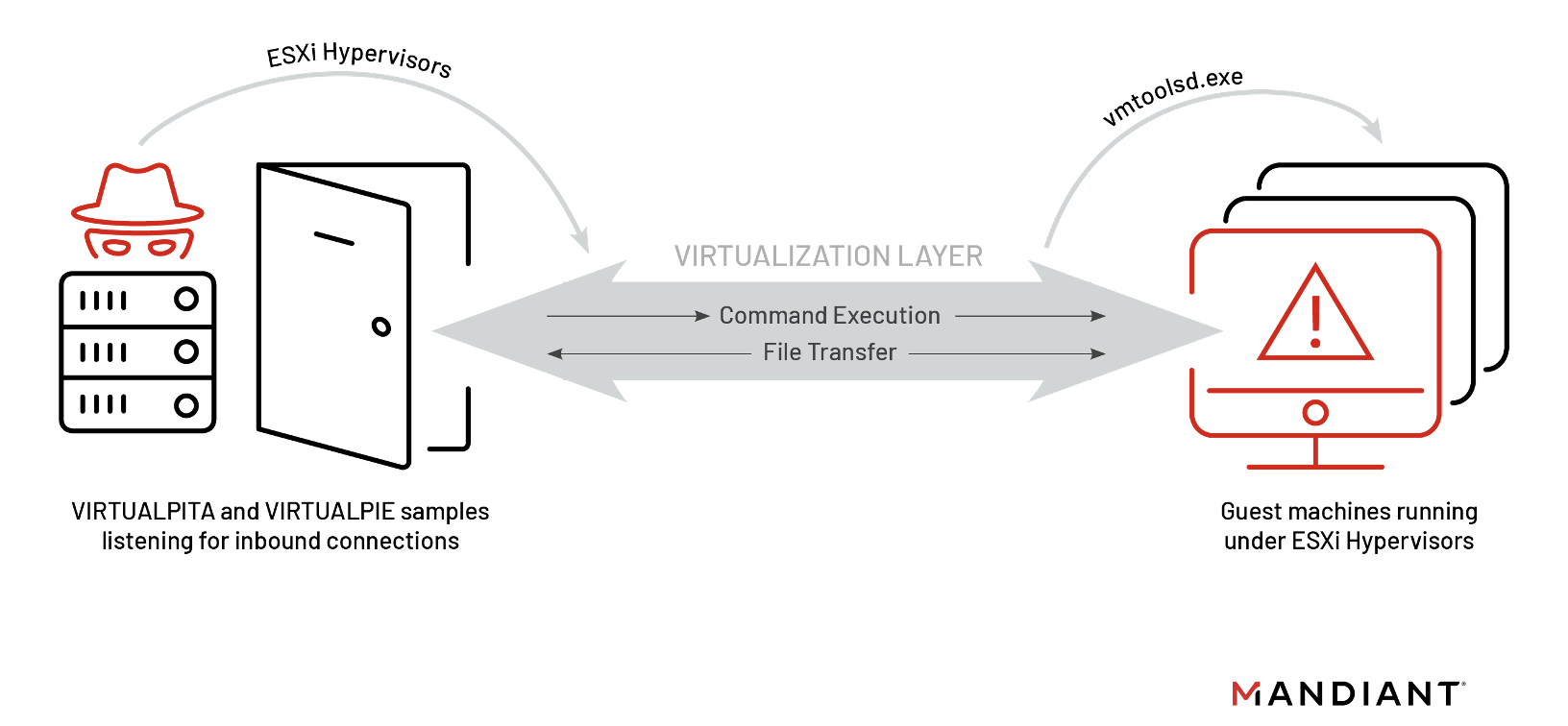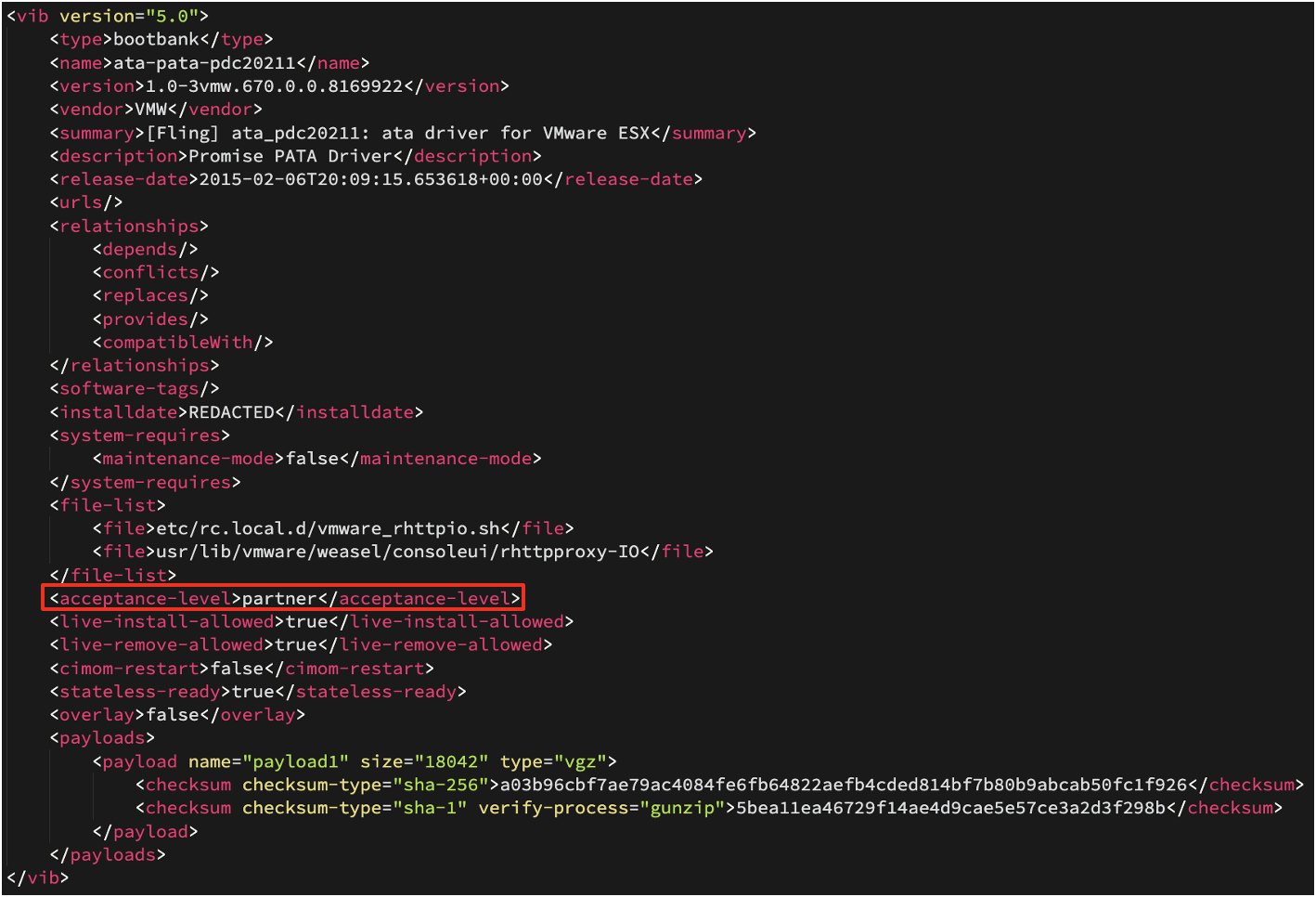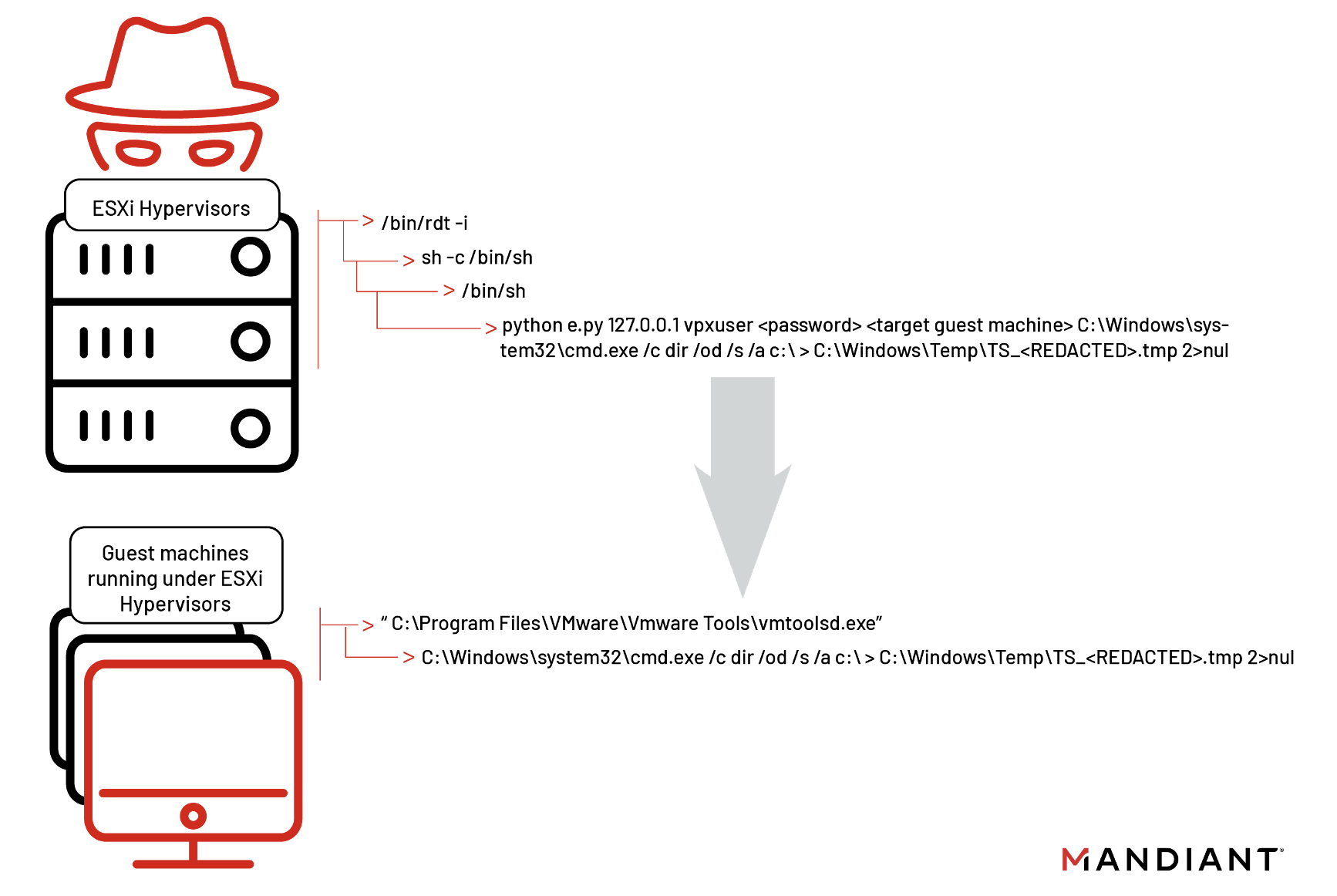As endpoint detection and response (EDR) solutions improve malware detection efficacy on Windows systems, certain state-sponsored threat actors have shifted to developing and deploying malware on systems that do not generally support EDR such as network appliances, SAN arrays, and VMware ESXi servers.
Earlier this year, Mandiant identified a novel malware ecosystem impacting VMware ESXi, Linux vCenter servers, and Windows virtual machines that enables a threat actor to take the following actions:
- Maintain persistent administrative access to the hypervisor
- Send commands to the hypervisor that will be routed to the guest VM for execution
- Transfer files between the ESXi hypervisor and guest machines running beneath it
- Tamper with logging services on the hypervisor
- Execute arbitrary commands from one guest VM to another guest VM running on the same hypervisor
This malware ecosystem was initially detected when Mandiant Managed Defense identified attacker commands sourced from the legitimate VMware Tools process, vmtoolsd.exe, on a Windows virtual machine hosted on a VMware ESXi hypervisor. Mandiant analyzed the boot profile for the ESXi hypervisors and identified a never-before-seen technique in which a threat actor leveraged malicious vSphere Installation Bundles (“VIBs”) to install multiple backdoors on the ESXi hypervisors. We call these backdoors VIRTUALPITA and VIRTUALPIE (Figure 1).

It is important to highlight that this is not an external remote code execution vulnerability; the attacker needs admin-level privileges to the ESXi hypervisor before they can deploy malware. Mandiant has no evidence of a zero-day vulnerability being used to gain initial access or deploy the malicious VIBs at the time of writing this post.
Details on how to manually detect if malicious or anomalous VIBs are currently installed in your ESXi environment are outlined in our hardening blog post. VMware has released additional information on protecting vSphere.
vSphere Installation Bundles (VIB)
Mandiant identified two (2) new malware families installed through malicious vSphere Installation Bundles (VIBs), which we have named VIRTUALPITA and VIRTUALPIE.
VMware VIBs are collections of files that are designed to facilitate software distribution and virtual system management. Since ESXi utilizes an in-memory filesystem, file edits are not saved across reboots. A VIB package can be used to create startup tasks, custom firewall rules, or deploy custom binaries upon the restart of an ESXi machine. These packages are generally utilized by administrators to deploy updates and maintain systems; however, this attacker was seen leveraging the packages as a persistence mechanism to maintain access across ESXi hypervisors.
VIBs can be broken down into three (3) components:
- An XML descriptor file
- A “VIB payload” (.vgz archive)
- A signature file – A digital signature used to verify the host acceptance level of a VIB
The XML Descriptor File is a config which contains references to the following:
- The payload to be installed
- VIB metadata, such as the name and install date
- The signature file that belongs to the VIB
The VIB payload is a .vgz archive which contains directories and files that will be created on the ESXi machine through the VIB. These files can then be called on to execute on boot when the VIBs are loaded.
The signature file is used to verify the host acceptance level of a VIB. The acceptance level is the digital signature system used by VMware to specify what testing has been done by VMware or partners before a VIB is published. Acceptance levels are set for hosts, image profiles, and individual VIBs. The four (4) acceptance levels along with their XML Descriptor short names are listed below:
- VMWareCertified (certified)
- VMwareAccepted (accepted)
- PartnerSupported (partner)
- CommunitySupported (community)
Per VMware documentation, the default minimum acceptance level a VIB needs to be installed on a ESXi host is PartnerSupported. This acceptance level indicates the VIBs are published by a partner that VMware trusts. While this is the default acceptance level, it can be changed manually by an ESXi administrative account. The command used to install VIBs esxcli software vib install does not normally allow installations below the minimum acceptance level, but the –force flag can be used to ignore any systems acceptance level requirements when installing the VIB.
The malicious VIBs observed were labelled as PartnerSupported. Mandiant’s review of the Signature Files determined they were empty, and that an attacker modified the XML descriptor file to change the acceptance-level field from community to partner. A CommunitySupported acceptance-level indicates that the VIB was created by a third party which was not reviewed nor signed by VMware or its trusted partners. This indicated the attacker masqueraded these VIB files as PartnerSupported even though they only met the requirements of a CommunitySupported VIB. This also indicated that the VIB was created by an individual or company outside of VMware partner programs and has not gone through any VMware-approved testing program. Figure 2 contains an excerpt of the modified XML descriptor file that was identified.

While the acceptance-level field was modified in the Descriptor XML by the attacker, the ESXi system still did not allow for a falsified VIB file to be installed below the minimal set acceptance level. To circumvent this, the attacker abused the --force flag to install malicious CommunitySupported VIBs.
Testing confirmed that modified fields from the XML descriptor file reflected the changes made in the output of commands used to list and verify VIBs. This included the modification of the <acceptance-level> field which tricks the command, esxcli software vib list, into displaying the incorrect acceptance level of the installed VIBs. The VMware command, esxcli software vib signature verify, verifies the signatures of installed VIB packages and displays the following fields:
- VIB Name
- Version
- Vendor
- Acceptance Level
- The result of the VIB’s signature verification
Mandiant confirmed that this command detected when these acceptance levels were falsified, which identified the malicious VIBs. This command displays the acceptance level specified by the XML descriptor file, but the Signature Verification column clarifies if the signature file did not match the respective Descriptor XML. If the signature cannot be verified, the Signature Verification column will contain the value Signature Not Available: Host may have been upgraded from an older ESXi version. An example of this can be seen in Figure 3.

VIRTUALPITA (VMware ESXi)
VIRTUALPITA is a 64-bit passive backdoor that creates a listener on a hardcoded port number on a VMware ESXi server. The backdoor often utilizes VMware service names and ports to masquerade as a legitimate service. It supports arbitrary command execution, file upload and download, and the ability to start and stop vmsyslogd. During arbitrary command execution, the malware also sets the environmental variable HISTFILE to 0 to further hide activity that occurred on the machine. Variants of this malware were found to listen on a Virtual Machine Communication Interface (VMCI) and log this activity to the file sysclog.
VIRTUALPIE (VMware ESXi)
VIRTUALPIE is a lightweight backdoor written in Python that spawns a daemonized IPv6 listener on a hardcoded port on a VMware ESXi server. It supports arbitrary command line execution, file transfer capabilities, and reverse shell capabilities. Communications use a custom protocol and are encrypted using RC4.
The first malicious VIB named lsu-lsi-lsi-mrarpid-plugin referenced the payload lsu_lsi_.v05 (MD5: 2716c60c28cf7f7568f55ac33313468b) which contained the following three (3) files for which details can be found in Table 1:
- /etc/rc.local.d/vmware_local.sh (MD5: bd6e38b6ff85ab02c1a4325e8af29ce4)
- /bin/rdt (MD5: 8e80b40b1298f022c7f3a96599806c43)
- /bin/vmsyslog.py (MD5: 61ab3f6401d60ec36cd3ac980a8deb75)
| File Name | Description |
| vmware_local.sh | A bash installation script to be placed into /etc/rc.local.d/ to ensure its actions will be executed upon each bootup of ESXi. Uses the esxcli command line utility to enable a firewall rule for backdoor traffic, execute both backdoors, and remove every file created by the VIB from the disk. |
| rdt | An ELF backdoor (VIRTUALPITA) that creates a listener on the hard coded TCP port 2233. Capable of arbitrary command execution, file transfer capabilities and the ability to start/stop vmsyslogd. VMWare documentation recorded this port is normally utilized by the vSAN reliable datagram transport (RDT) service on the ESXi version which was reviewed. |
| vmsyslog.py | A lightweight backdoor (VIRTUALPIE) written in Python that spawns a daemonized IPv6 listener the hardcoded port 546. Capable of arbitrary command line execution, file transfer capabilities, and reverse shell capabilities. Communications use a custom protocol and are encrypted using RC4. |
The second malicious VIB named ata-pata-pdc20211 referenced the payload payload1.v00 (MD5: 9ea86dccd5bbde47f8641b62a1eeff07) which contained the following two (2) files for which details can be found in Table 2:
- /etc/rc.local.d/vmware_rhttpio.sh (MD5: 9d5cc1ee99ccb1ec4d20be1cee10173e)
- /usr/lib/vmware/weasel/consoleui/rhttpproxy-io (MD5: 2c28ec2d541f555b2838099ca849f965)
| File Name | Description |
| vmware_rhttpio.sh | A bash installation script to be placed into /etc/rc.local.d/ to ensure its actions will be executed upon each bootup of ESXi. This script executes the ELF backdoor |
| rhttpproxy-io | An ELF backdoor (VIRTUALPITA) that creates a listener on the hard coded VMCI socket port 18098. Capable of arbitrary command execution, file transfer capabilities and the ability to start/stop vmsyslogd. The following sample generates an additional log not seen in other samples which fetches the systems context ID (CID). The generated log /var/log/sysclog records in the following format [<date/timestamp>]nr[!]<<PID>>:<CID>:<port>nn |
VIRTUALPITA (LINUX)
Mandiant discovered two (2) additional VIRTUALPITA samples listening on TCP port 7475 that were persistent as an init.d startup service on Linux vCenter systems. To disguise themselves, the binaries shared the name of the legitimate binary ksmd. KSMD (Kernel Same-Page Merging Daemon) is normally in charge of memory-saving de-duplication on Linux and would not be listening on this port. The samples were found under the following directories:
- /usr/libexec/setconf/ksmd (MD5: 744e2a4c1da48869776827d461c2b2ec)
- /usr/bin/ksmd (MD5: 93d50025b81d3dbcb2e25d15cae03428)
These backdoors were capable of arbitrary command execution, file transfer capabilities and the ability to start/stop vmsyslogd.
VIRTUALGATE (Windows)
The Windows guest virtual machines which were hosted by the infected hypervisors also contained a unique malware sample located at C:WindowsTempavp.exe. This malware, which we refer to as VIRTUALGATE, is a utility program written in C that is comprised of two (2) parts, a dropper, and the payload. The memory only dropper deobfuscates a second stage DLL payload that uses VMware’s virtual machine communication interface (VMCI) sockets to run commands on a guest virtual machine from a hypervisor host, or between guest virtual machines on the same host.
Command Execution through vmtoolsd.exe
Reviewing the ESXi hypervisors during an active attacker event, Mandiant identified an attacker executed commands to the guest machines through the process /bin/rdt (VIRTUALPITA). The parent process /bin/rdt spawned a bash shell which called on a python script specifying the target guest machine and commands to run as seen in Figure 4.
|
|
Commands passed as arguments into e.py were also seen being executed by the targeted Windows guest machine, running as a child process under vmtoolsd.exe. This execution chain can be seen in Figure 5. The parent binary /bin/rdt was not present on disk but was able to be recovered by dumping the processes memory of the ESXi hypervisor. The python script that sent out commands to the guest machines, e.py, was unable to be recovered.

The commands the attacker ran through vmtoolsd.exe on the guest virtual machines were primarily focused on the enumeration and compression of files across both the system and connected file shares utilizing the native tools “dir” and “makecab”. Samples of these redacted commands can be seen in Figure 6.
|
|
Mandiant also identified the attacker targeting a virtualized system for credential harvesting. The attacker used MiniDump to dump process memory and search for cleartext credentials. Figure 7 shows an excerpt of these commands.
|
|
Once the process memory was dumped, a powershell script was used to parse the resultant file for any cleartext credentials. Figure 8 shows the contents of script used for credential harvesting. The attacker also targeted KeyPass password database files.
|
|
The attacker cleared the C:WindowsTemp directory following most activity, but small errors were made which left behind trace artifacts. As shown in Figure 9, the attacker sent the output of a dir listing to a .tmp file. Since the attacker used the Linux syntax (2>null) to suppress errors instead of the Windows syntax (2>nul), all errors were forwarded to the file null in the working directory C:WindowsSystem32null. This file was only created if a file enumerated with the dir command had a directory path too long to be displayed.
|
|
Attribution
Mandiant has begun tracking this activity as UNC3886. Given the highly targeted and evasive nature of this intrusion, we suspect UNC3886 motivation to be cyber espionage related. Additionally, we assess with low confidence that UNC3886 has a China-nexus. Each investigation conducted by Mandiant includes analysts from our Advanced Practices team who work to correlate activity observed in the thousands of investigations to which Mandiant responds. At times, we do not have the data available to directly attribute intrusion activity to a previously known group. In these cases, we create a new UNC group to track the activity that we observed. An UNC group is a cluster of related cyber intrusion activity, which includes observable artifacts such as adversary infrastructure, tools, and tradecraft, that we are not yet ready to give a classification such as APT or FIN. For more details on how Mandiant uses UNC groups, see our blog post: DebUNCing Attribution: How Mandiant Tracks Uncategorized Threat Actors.
Conclusion
While we noted the technique used by UNC3886 requires a deeper level of understanding of the ESXi operating system and VMWare’s virtualization platform, we anticipate a variety of other threat actors will use the information outlined in this research to begin building out similar capabilities. Mandiant recommends organizations using ESXi and the VMware infrastructure suite follow the hardening steps outlined in this blog post to minimize the attack surface of ESXi hosts.
MITRE ATT&CK Techniques
Collection
- T1560: Archive Collected Data
- T1560.001: Archive via Utility
Execution
- T1059: Command and Scripting Interpreter
- T1059.001: PowerShell
- T1059.003: Windows Command Shell
- T1059.004: Unix Shell
- T1059.006: Python
- T1129: Shared Modules
Command and Control
- T1105: Ingress Tool Transfer
- T1573.001: Symmetric Cryptography
Defense Evasion
- T1027: Obfuscated Files or Information
- T1070: Indicator Removal on Host
- T1070.003: Clear Command History
- T1070.004: File Deletion
- T1140: Deobfuscate/Decode Files or Information
- T1202: Indirect Command Execution
- T1218.011: Rundll32
- T1497: Virtualization/Sandbox Evasion
- T1497.001: System Checks
- T1620: Reflective Code Loading
Discovery
- T1016: System Network Configuration Discovery
- T1083: File and Directory Discovery
Lateral Movement
- T1021: Remote Services
- T1021.004: SSH
Credential Access
- T1003: OS Credential Dumping
- T1003.001: LSASS Memory
Persistence
- T1547: Boot or Logon Autostart Execution
Indicators of Compromise
| Type | Value | Description |
|
MD5 SHA1 SHA256 |
2716c60c28cf7f7568f55ac33313468b 5ffa6d539a4d7bf5aacc4d32e198cc1607d4a522 2be5f4520846bf493b4694789841907d058fe08d59fff6bad7abe1db8ed96e7d |
Malicious VIB .vgz Payload |
|
MD5 SHA1 SHA256 |
bd6e38b6ff85ab02c1a4325e8af29ce4 17fb90d01403cb3d1566c91560f8f4b7dd139aa8 e68872c49aaedeb3bde3ff5fd2ad6f70658687dc02d04f12ebc7cb28e821cc88 |
Malicious VIB Deployment Script |
|
MD5 SHA1 SHA256 |
8e80b40b1298f022c7f3a96599806c43 e9cbac1f64587ce1dc5b92cde9637affb3b58577 c2ef08af063f6d416233a4b2b2e991c177fc72d70a76c24bca9080521d41040f |
VIRTUALPITA |
|
MD5 SHA1 SHA256 |
61ab3f6401d60ec36cd3ac980a8deb75 93d5c4ebec2aa45dcbd6ddbaad5d80614af82f84 4cf3e0b60e880e6a6ba9f45187ac5454813ae8c2031966d8b264ae0d1e15e70d |
VIRTUALPIE |
|
MD5 SHA1 SHA256 |
9ea86dccd5bbde47f8641b62a1eeff07 b90b19781fde2c35963eb3eac4ce2acc6f5019fb 23eb8d056f18e7c69ec3568f2833c9d09e91df98d11b11de235331ef42756fe5 |
Malicious VIB Payload |
|
MD5 SHA1 SHA256 |
9d5cc1ee99ccb1ec4d20be1cee10173e 9d191849d6c57bc8a052ec3dac2aa9f57c3fe0cd 4d995eb87b0685124b7f1640d1ab431f5a1ab991ade02750b876ed5c523234bb |
Malicious VIB Deployment Script |
|
MD5 SHA1 SHA256 |
2c28ec2d541f555b2838099ca849f965 e35733db8061b57b8fcdb83ab51a90d0a8ba618c 505eb3b90cd107cf7e2c20189889afdff813b2fbb98bbdeab65cde520893b168 |
VIRTUALPITA |
|
MD5 SHA1 SHA256 |
744e2a4c1da48869776827d461c2b2ec a3cc666e0764e856e65275bd4f32a56d76e51420 4a6f559426493abc0d056665f23457e2779abd3482434623e1f61f4cd5b41843 |
VIRTUALPITA |
|
MD5 SHA1 SHA256 |
93d50025b81d3dbcb2e25d15cae03428 abff003edf67e77667f56bbcfc391e2175cb0f8a 13f11c81331bdce711139f985e6c525915a72dc5443fbbfe99c8ec1dd7ad2209 |
VIRTUALPITA |
|
MD5 SHA1 SHA256 |
fe34b7c071d96dac498b72a4a07cb246 0962e10dc34256c6b31509a5ced498f8f6a3d6b6 5731d988781c9a1d2941f7333615f6292fb359f6d48498f32c29878b5bedf00f |
VIRTUALPITA |
| Descriptor XML Name | lsu-lsi-lsi-mrarpid-plugin | VIB Name |
| Filename | lsu_lsi_.v05 | VIB .vgz payload |
| Fullpath | /etc/rc.local.d/vmware_local.sh | VIB Deployment Script |
| Fullpath | /bin/rdt | VIRTUALPITA |
| Fullpath | /bin/vmsyslog.py | |
| Descriptor XML Name | ata-pata-pdc20211 | VIB Name |
| Filename | payload1.v00 | VIB .vgz payload |
| Fullpath | /etc/rc.local.d/vmware_rhttpio.sh | VIB Deployment Script |
| Fullpath | /usr/lib/vmware/weasel/consoleui/rhttpproxy-io | VIRTUALPITA |
| Fullpath | /usr/libexec/setconf/ksmd | VIRTUALPITA (Linux) |
| Fullpath | /usr/bin/ksmd | VIRTUALPITA (Linux) |
| Fullpath | C:WindowsTempavp.exe | VIRTUALGATE |
| Fullpath and Hash (MD5) | C:WindowsTempSilverlightwmpd.exe 76df41ee75d5077f2c5bec70747b3c99 |
Deleted File created by vmtoolsd.exe and executed by vmtoolsd.exe child process |
Yara Detections
|
|
|
|
|
|
|
|
|
|
|
|
Acknowledgements
Special thanks to Brad Slaybaugh, Joshua Kim, Zachary Smith, Kirstie Failey, Nick Simonian, and Charles Carmakal for their assistance with the investigation, technical review, and creating detections for the malware families discussed in this blog post. In addition, we would also like to thank VMware for their collaboration on this research.
Source: https://www.mandiant.com/resources/blog/esxi-hypervisors-malware-persistence
